Quantitative Verification of Concrete Formwork-Striking-Time Reduction by High Blaine Ordinary Portland Cement
Abstract
:1. Introduction
2. Experimental Procedures
2.1. Experimental Design
2.2. Materials
2.3. Experimental Methods
3. Results and Discussion
3.1. Properties of Fresh Concrete
3.2. Temperature History
3.3. Setting Time
3.4. Compressive Strength
3.5. Maturity
3.6. Determination of Demolding Time
4. Conclusions
- The results from temperature history measurement revealed that the IHB and rapid-hardening cement showed rapid hydration rates and high maximum temperatures at 20 °C curing. However, this difference decreased at lower curing temperatures.
- Compared to that of OPC, the setting time of the concrete using IHB was reduced by approximately 5.4 h and 6.3 h for the initial and final settings, respectively. Thus, the early-strength-development property of IHB was found to be close to that of the rapid-hardening cement.
- The compressive strength at the early age was larger in the rapid-hardening cement and the mixture using IHB, and the strength difference with the OPC increased as the temperature decreased.
- When IHB was used, the mechanical properties after 28 d were better than those of OPC. However, the long-term strength and durability characteristics should be studied further, because the long-term strength of rapid-hardening cement is generally known to be reversed with the general mix.
- At higher curing temperatures, maturity increased more rapidly, and the maturity difference increased with time. The maturity at the same elapsed time was approximately 70% and 50% at 10 °C and 5 °C, compared to that at 20 °C.
- The result of the regression analysis between maturity and compressive strength indicated that there is a significant correlation, with a coefficient of determination of 0.90 or more under most conditions.
- For improved accuracy of determination of the formwork striking time, the linear interpolation method and the maturity method were compared and analyzed. The possible formwork striking time was determined using the average of these two methods.
- Compared to ordinary cement, IHB enabled earlier formwork striking, due to earlier strength expression. In particular, below 10 °C, the construction time reduction of approximately 1 d was possible for vertical formwork and up to 2 d for horizontal formwork.
Author Contributions
Funding
Institutional Review Board Statement
Informed Consent Statement
Data Availability Statement
Conflicts of Interest
References
- Yoon, G.W.; Lee, Y.E.; Baek, D.H. Determination of removal time of form. In Proceedings of the 2002 Korea Concrete Institute Autumn Conference, Seoul, Republic of Korea, November 2002. [Google Scholar]
- Price, W.H. Factors influencing concrete strength. J. Am. Concr. Institute 1951, 47, 417–432. [Google Scholar] [CrossRef]
- Hamooni, M.; Maghrebi, M.; Majrouhi, S.J.; Kim, S. Extending BIM interoperability for real-time concrete formwork process monitoring. Appl. Sci. 2020, 10, 1085. [Google Scholar] [CrossRef] [Green Version]
- Lee, T.; Lee, J.; Kim, J.; Choi, H.; Lee, D. Effect of formwork removal time reduction on construction productivity improvement by mix design of early strength concrete. Appl. Sci. 2020, 10, 7046. [Google Scholar] [CrossRef]
- Vanhove, Y.; Djelal, C. Influence of the formwork removal by polarization on the facing aesthetics in reinforced concrete. Constr. Build. Mater. 2021, 284, 122841. [Google Scholar] [CrossRef]
- Santilli, A.; Teixeira, S.; Puente, I. Influence of temperature and concrete reinforcement on vertical formwork design. Constr. Build. Mater. 2015, 88, 188–195. [Google Scholar] [CrossRef]
- KSC 14 20 12; Formwork and Copper Bars. Concrete Standard Specification: Seoul, Republic of Korea, 2022.
- Ahmed, S.; Al-Dawood, J.; Abed, F.; Mannan, M.A.; Al-Samarai, M. Impact of using different materials, curing regimes, and mixing procedures on compressive strength of reactive powder concrete—A review. J. Build. Eng. 2021, 44, 103238. [Google Scholar] [CrossRef]
- Shi, J.; Liu, B.; Wu, X.; Qin, J.; Jiang, J.; He, Z. Evolution of mechanical properties and permeability of concrete during steam curing process. J. Build. Eng. 2020, 32, 101796. [Google Scholar] [CrossRef]
- Peter, H. Portland Cement: Classification and Manufacture. In Lea’s Chemistry of Cement and Concrete, 4th ed.; Arnold and Wiley: New York, NY, USA, 1999; pp. 24–95. [Google Scholar]
- Mehta, P.K.; Monteiro, P.J. Concrete Microstructure, Properties, and Materials, 2nd ed.; Prentice Hall: New York, NY, USA, 1993. [Google Scholar]
- Brooks, J.J.; Megat Johari, M.A.; Mazloom, M. Effect of admixtures on the setting times of high-strength concrete. Cem. Concr. Compos. 2000, 22, 293–301. [Google Scholar] [CrossRef]
- Rixon, R.; Mailvaganam, N. Chemical Admixtures for Concrete, 3rd ed.; E and F N Spon: London, UK, 1999. [Google Scholar]
- Scrivener, K.L.; Juilland, P.; Monteiro, P.J. Advances in understanding hydration of Portland cement. Cem. Concr. Res. 2015, 78, 38–56. [Google Scholar] [CrossRef]
- Kim, J.K.; Moon, Y.H.; Eo, S.H. Compressive strength development of concrete with different curing time and temperature. Cem. Concr. Res. 1998, 28, 1761–1773. [Google Scholar] [CrossRef]
- Lura, P.; Breugel, K.; Maruyama, I. Effect of curing temperature and type of cement on early-age shrinkage of high-performance concrete. Cem. Concr. Res. 2001, 31, 1867–1872. [Google Scholar] [CrossRef]
- Burg, R.G. The Influence of Casting and Curing Temperature on the Properties of Fresh and Hardened Concrete; No. R&D Bulletin RD113T; Portland Press Cement Association: Skokie, IL, USA, 1996. [Google Scholar]
- Klieger, P. Effect of mixing and curing temperatures on concrete strength. J. Am. Concr. Institute. 1958, 54, 1063–1081. [Google Scholar]
- Min, T.B.; Cho, I.; Park, W.; Choi, H.; Lee, H. Experimental study on the development of compressive strength of early concrete age using calcium-based hardening accelerator and high early strength cement. Constr. Build. Mater. 2014, 64, 208–214. [Google Scholar] [CrossRef]
- Wang, C.; Song, M. Influence of water-cement ratio and type of mixing water on the early hydration performance of calcium sulphoaluminate (CSA) cement. Adv. Mater. Sci. Eng. 2021, 2021, 1–10. [Google Scholar] [CrossRef]
- Shi, J.; Liu, B.; Tan, J.; Dai, J.; Chen, J.; Ji, R. Experimental studies and microstructure analysis for rapid-hardening cement emulsified asphalt mortar. J. Constr. Eng. Manag. 2020, 146, 04020130. [Google Scholar] [CrossRef]
- Frantzis, P. Effect of early-age temperature rise on the stability of rapid-hardening cement fiber composites. J. Mater. Civ. Eng. 2006, 18, 568–575. [Google Scholar] [CrossRef]
- Mardani, A.A.; Son, A.E.; Felekoglu, B.; Ramyar, K. Effect of cement fineness on properties of cementitious materials containing high range water reducing admixture. J. Green Build. 2017, 12, 142–167. [Google Scholar] [CrossRef]
- ACI 347-04; Guide to Formwork for Concrete. ACI Committee: Farmington Hills, MI, USA, 2005.
- Ceb-Fip Model Code 1990; 1993: Design Code. Thomas Telford: London, UK, 1993.
- BS EN 13670:2009; Execution of Concrete Structures. BSI: London, UK, 2010.
- KASS 5; Korea Architectural Standard Specification Reinforced Concrete Work. Architectural Institute of Korea: Seoul, Republic of Korea, 2009.
- JASS 5; Japanese Architectural Standard Specification Reinforced Concrete Work. Architectural Institute of Japan: Tokyo, Japan, 2009.
- Helal, J.; Sofi, M.; Mendis, P. Non-destructive testing of concrete: A review of methods. Electron. J. Struct. Eng. 2015, 14, 97–105. [Google Scholar] [CrossRef]
- Malek, J.; Kaouther, M. Destructive and non-destructive testing of concrete structures. Jordan J. Civ. Eng. 2014, 8, 432–441. [Google Scholar]
- Figueira, R.B. Electrochemical sensors for monitoring the corrosion conditions of reinforced concrete structures: A review. Appl. Sci. 2017, 7, 1157. [Google Scholar] [CrossRef] [Green Version]
- Bye, G.C. Portland Cement: Composition, Production and Properties; Thomas Telford: London, UK, 1999. [Google Scholar]
- KS F 2402; Standard Test Method for Concrete Slump. Korea Standard Committee: Seoul, Republic of Korea, 2017.
- KS F 2421; Standard Test Method for Air Content of Fresh Concrete by the Pressure Method (Air Receiver Method). Korea Standard Committee: Seoul, Republic of Korea, 2021.
- KS F 2436; Standard Test Method for Setting Times of Concrete Mixture by Penetration Resistance. Korea Standard Committee: Seoul, Republic of Korea, 2017.
- KS F 2405; Standard Test Method for Compressive Strength of Concrete. Korea Standard Committee: Seoul, Republic of Korea, 2017.
- Saul, A.G.A. Principles Underlying The Steam Curing of Concrete at Atmospheric Pressure. Mag. Concr. Res. 1951, 2, 127–140. [Google Scholar] [CrossRef]
- Hansen, P.F.; Pederson, J. Maturity Computer for Controlled Curing and Hardening of Concrete Strength; Nordiska Betongfoerbundet: Stockhom, Sweden, 1977; pp. 21–25. [Google Scholar]
- Plowman, J.M. Maturity and The Strength of Concrete. Mag. Concr. Res. 1956, 8, 13–22. [Google Scholar] [CrossRef]
- Cario, N.J. Maturity Method: Theory and Application. J. Cem. Aggreg. 1984, 6, 61–73. [Google Scholar]
- ASTM C1074; Standard practice for estimating concrete strength by the maturity method. American Society of Testing and Materials: West Conshohocken, PE, USA, 2019; pp. 1–10.
- Gaynor, R.D.; Meininger, R.C.; Khan, T.S. Effect of Temperature and Delivery Time on Concrete Proportions. In Temperature Effects on Concrete; ASTM International: West Conshohocken, PE, USA, 1985. [Google Scholar]
- Kim, H.K.; Jeon, J.H.; Lee, H.K. Workability, and mechanical, acoustic and thermal properties of lightweight aggregate concrete with a high volume of entrained air. Constr. Build. Mater. 2012, 29, 193–200. [Google Scholar] [CrossRef]
- Han, C.G.; Han, M.C.; Lee, D.G. Influence of over-added AE water reducing agent on physical properties of the concrete. J. Korea Inst. Build Constr. 2008, 8, 91–96. [Google Scholar] [CrossRef] [Green Version]
- Yi, S.T.; Moon, Y.H.; Kim, J.K. Long-term strength prediction of concrete with curing temperature. Cem. Concr. Res. 2005, 35, 1961–1969. [Google Scholar] [CrossRef]
- Schachinger, I.; Hilbig, H.; Stengel, T.; Fehling, E. Effect of curing temperature at an early age on the long-term strength development of UHPC. In Proceedings of the 2nd International Symposium on Ultra High Performance Concrete, Kassel, Germany, 5–7 March 2008. [Google Scholar]
- Ayub, T.; Khan, S.U.; Memon, F.A. Mechanical characteristics of hardened concrete with different mineral admixtures: A review. Sci. World J. 2014, 2014, 875082. [Google Scholar] [CrossRef] [PubMed]
- Kim, K.; Park, S.; Moon, K.; Shim, J. Characteristics of compressive strength of concrete due to form curing condition. KSCE J. Civ. Environ. Eng. Res. 2018, 38, 19–28. [Google Scholar]
- Kim, G.D.; Lee, S.H.; La, W.; Hwang, Y.S. The practical use of early strength development technology for form stripping earlier than normal state in apartment. In Proceedings of the Korea Concrete Institute Conference, November 2004; pp. 765–768. [Google Scholar]
- Cho, H.B.; Kim, H.Y.; Lee, Y.D.; Jumg, S.J. Effect of maintaining time of formwork on strength and dry shrinkage of mock-up concrete in cold weather condition. J. Archit. Inst. Korea Struct Constr. 2013, 297, 109–116. [Google Scholar]
- Li, G.; Luo, M.; Huang, J.; Li, W. Early-age concrete strength monitoring using smart aggregate based on electromechanical impedance and machine learning. Mech. Syst. Signal Process. 2023, 186, 109865. [Google Scholar] [CrossRef]
- Kaewunruen, S.; Meesit, R.; Mondal, P. Early-age dynamic moduli of crumbed rubber concrete for compliant railway structures. J. Sustain. Cem. Based Mater. 2017, 6, 281–292. [Google Scholar] [CrossRef]
- Zheng, Z.; Wei, X. Mesoscopic models and numerical simulations of the temperature field and hydration degree in early-age concrete. Constr. Build. Mater. 2021, 266, 121001. [Google Scholar] [CrossRef]
- Voigt, T.; Sun, Z.; Shah, S.P. Comparison of ultrasonic wave reflection method and maturity method in evaluating early-age compressive strength of mortar. Cem. Concr. Compos. 2006, 28, 307–316. [Google Scholar] [CrossRef]
- Lee, S.C. Prediction of concrete strength using artificial neural networks. Eng. Struct. 2003, 25, 849–857. [Google Scholar] [CrossRef]
- Yikici, T.A.; Chen, H.L.R. Use of maturity method to estimate compressive strength of mass concrete. Constr. Build. Mater. 2015, 95, 802–812. [Google Scholar] [CrossRef]
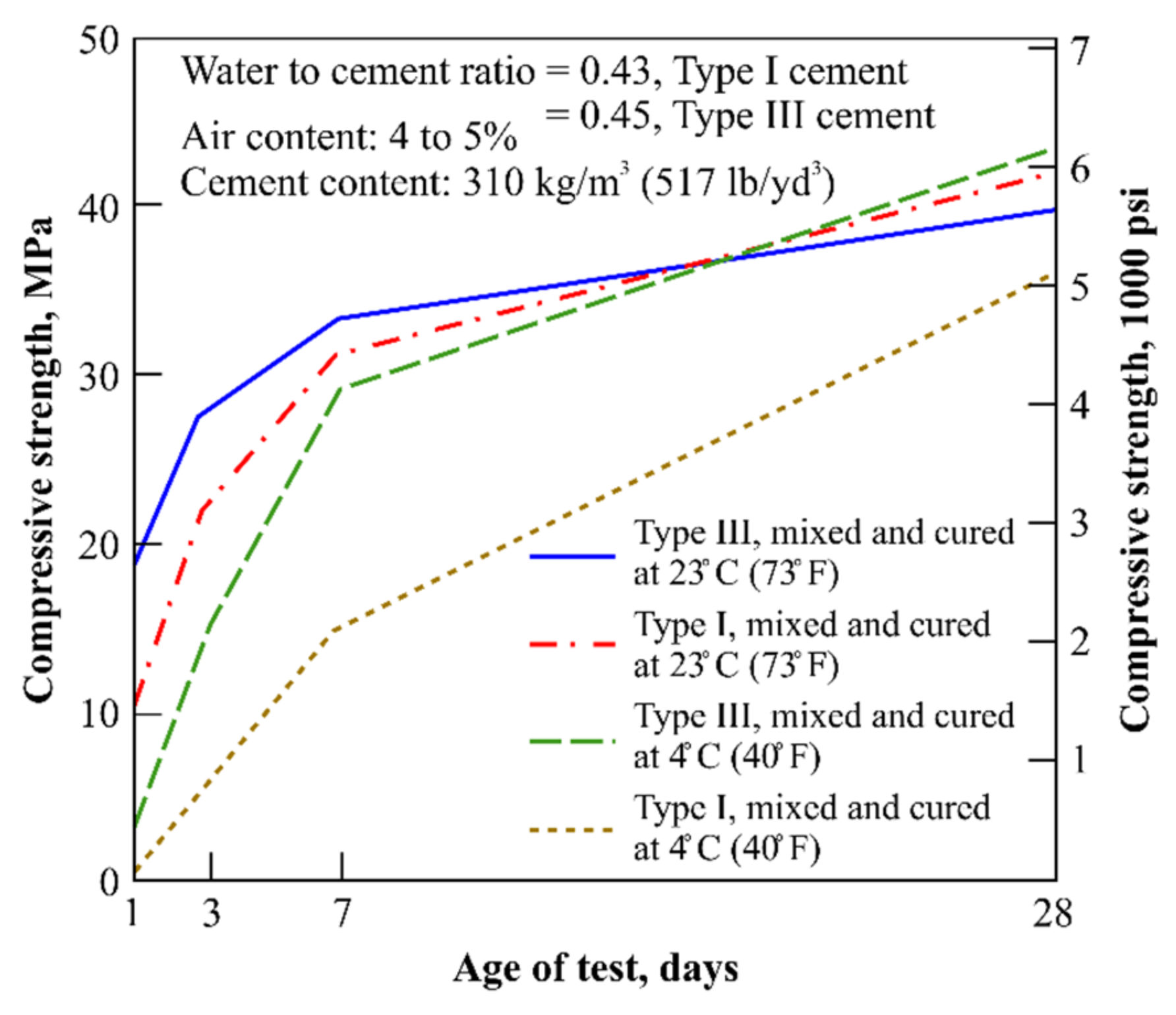
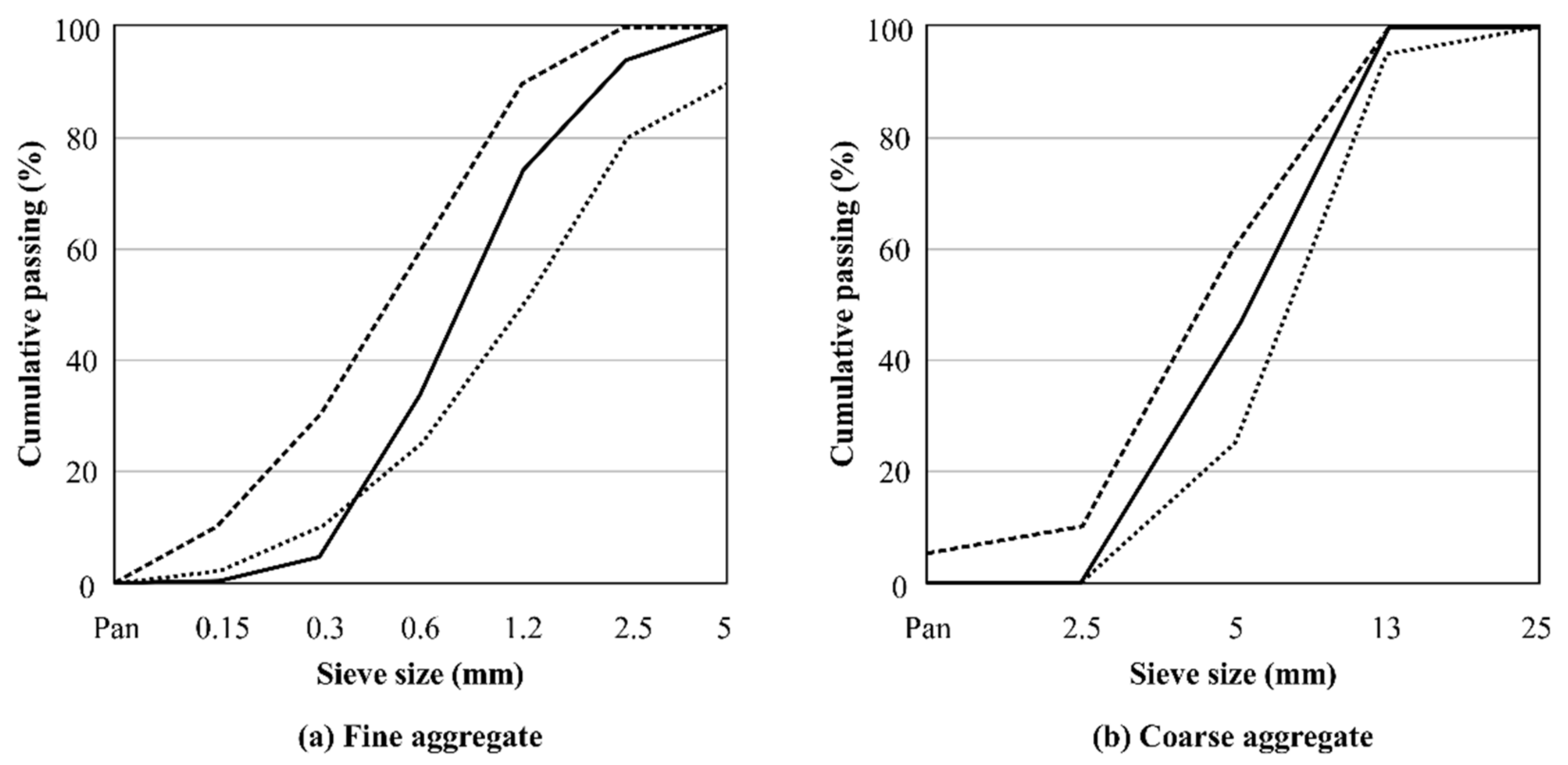


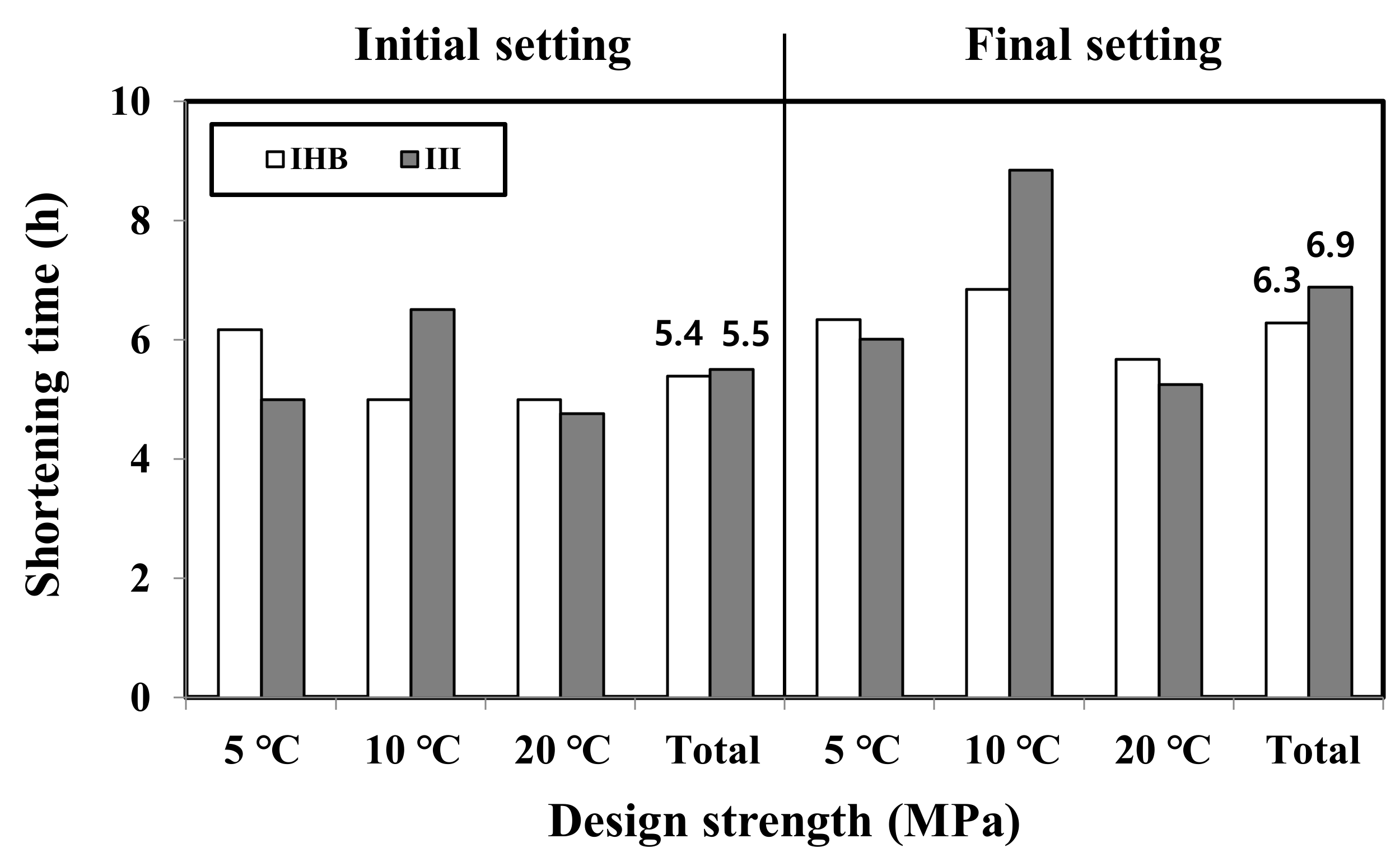
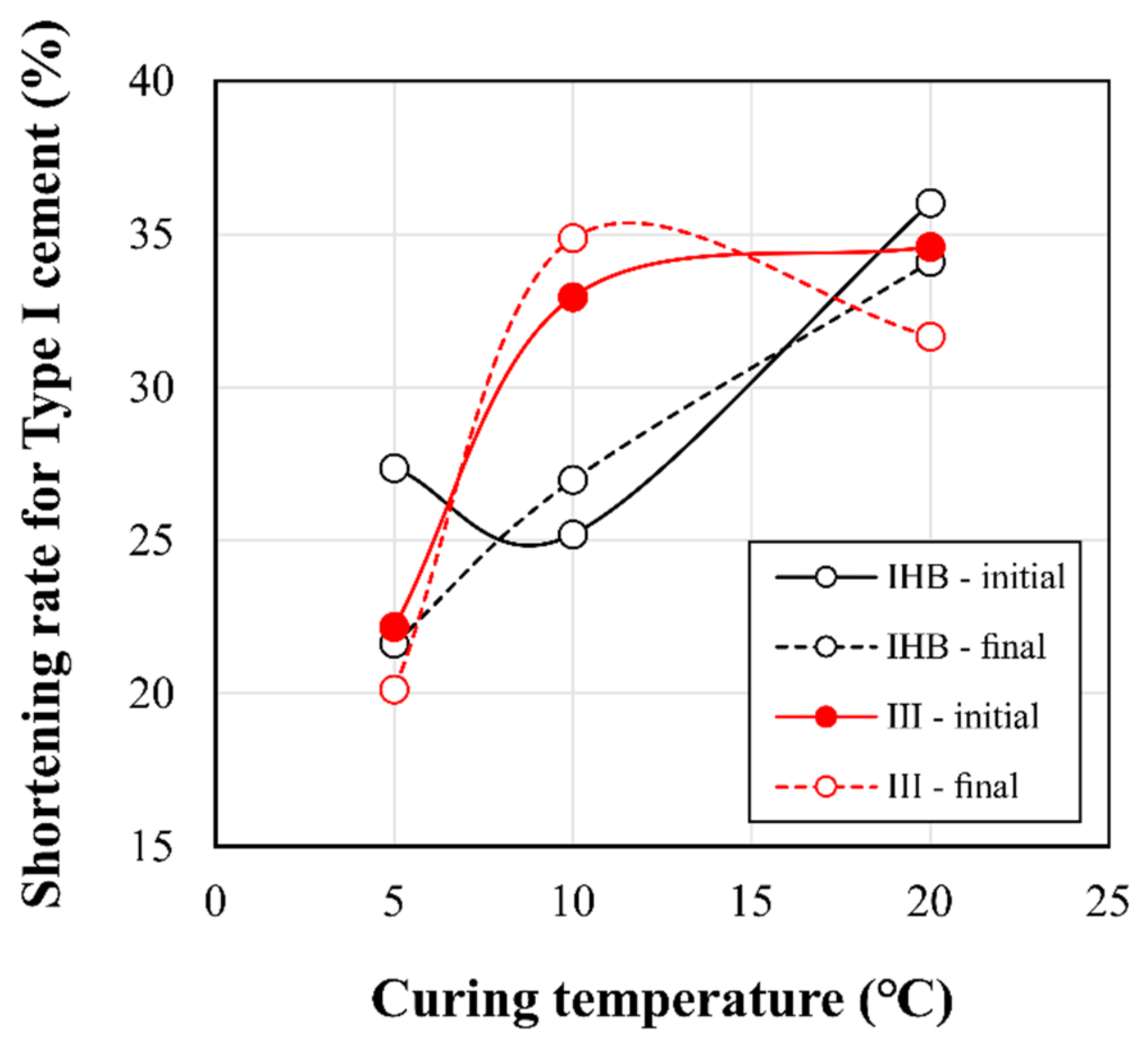



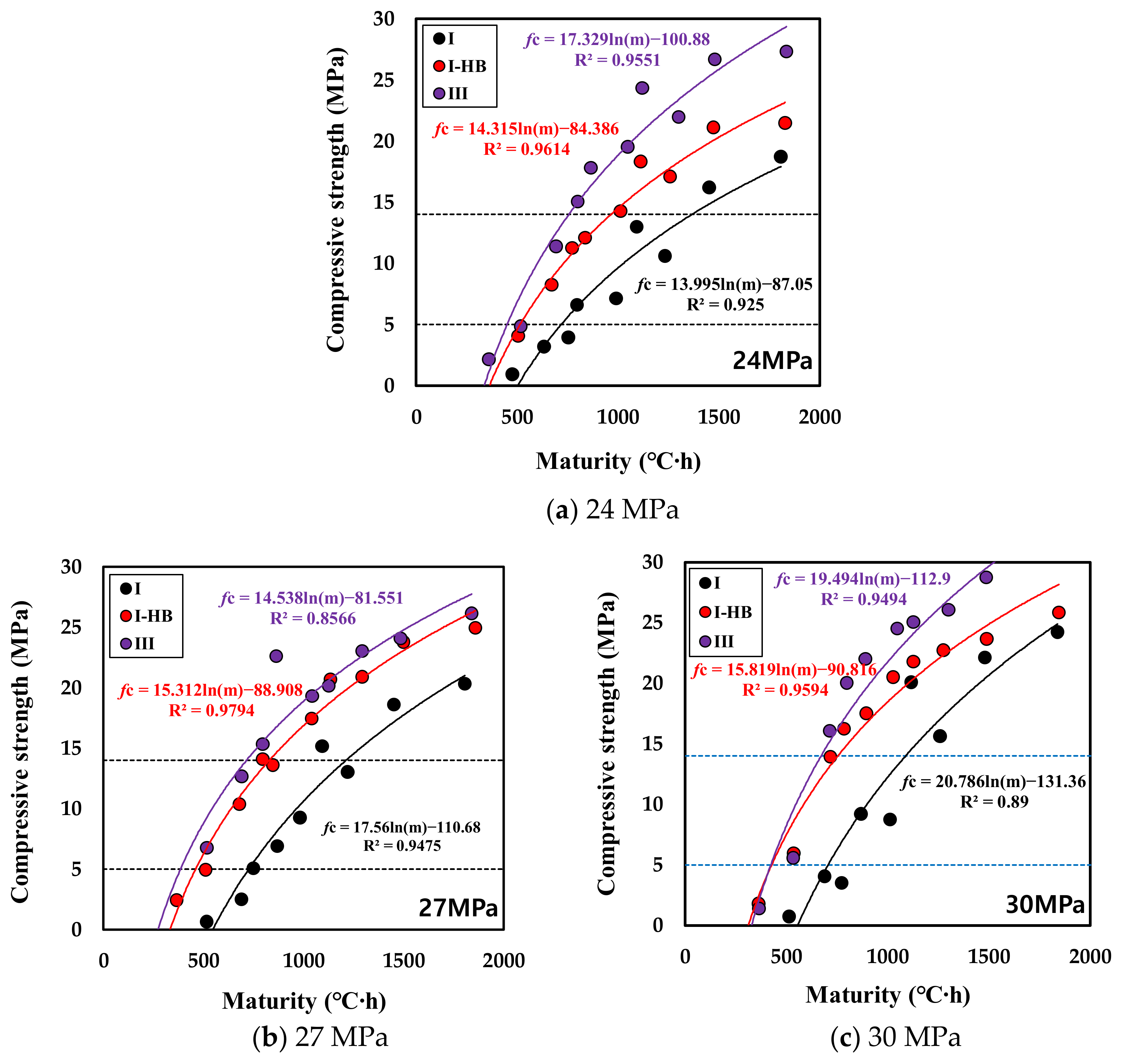
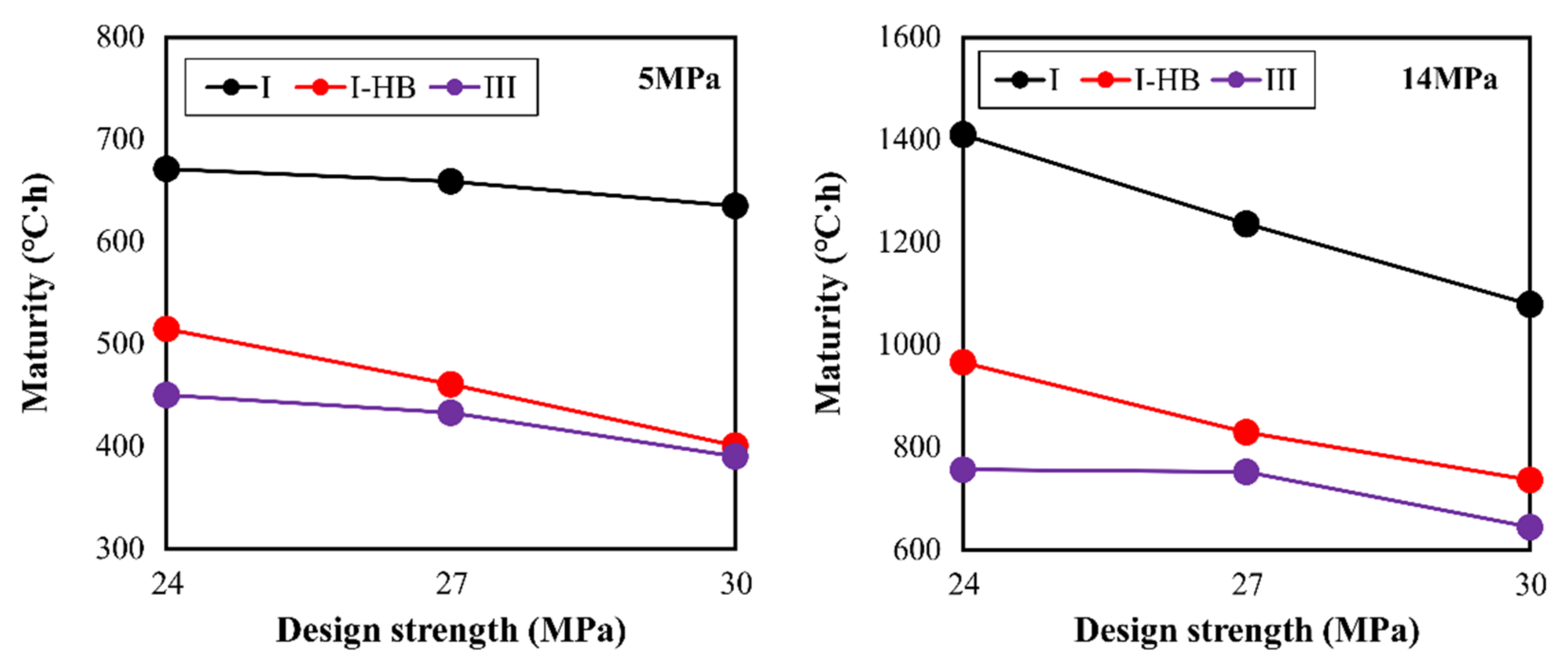
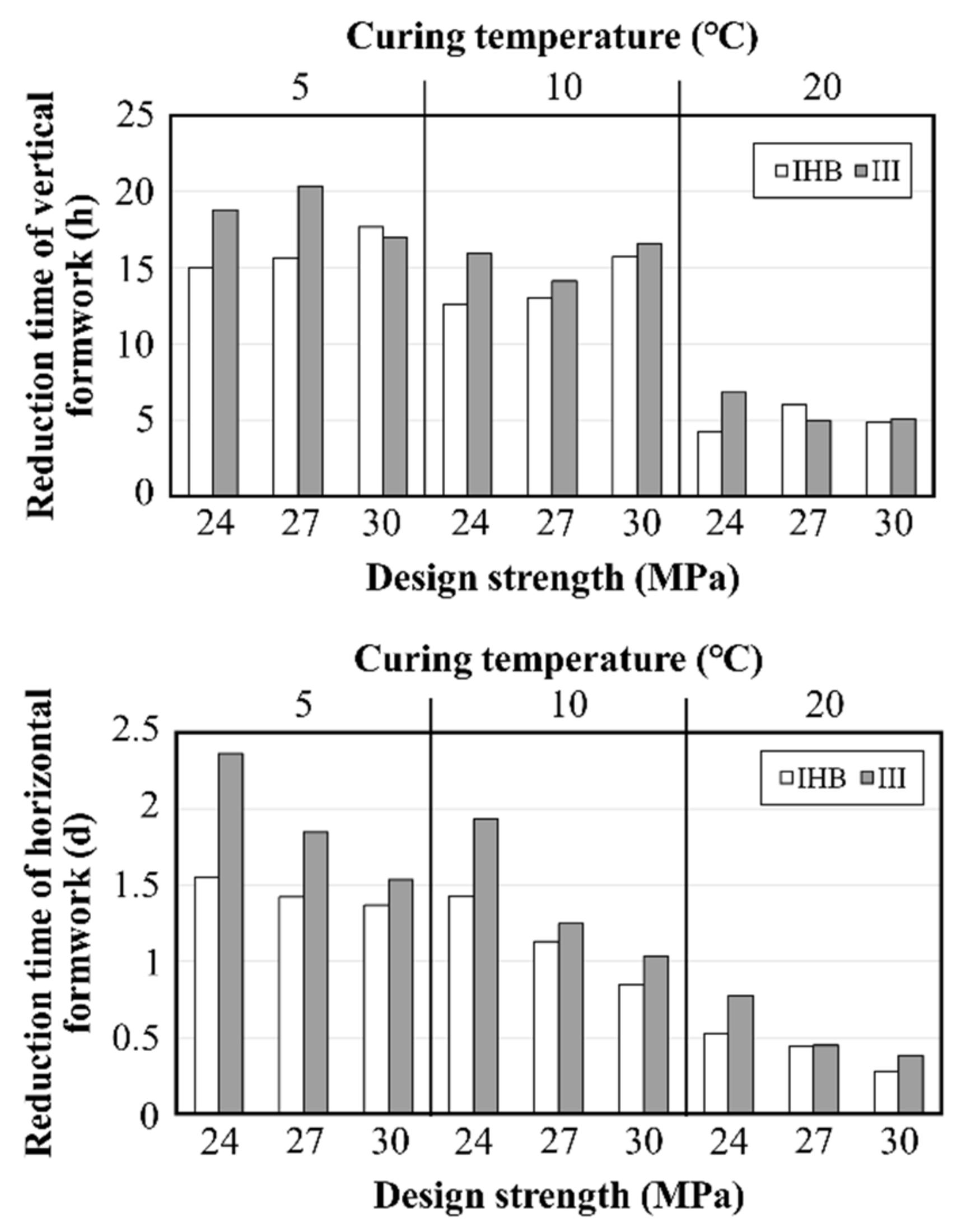
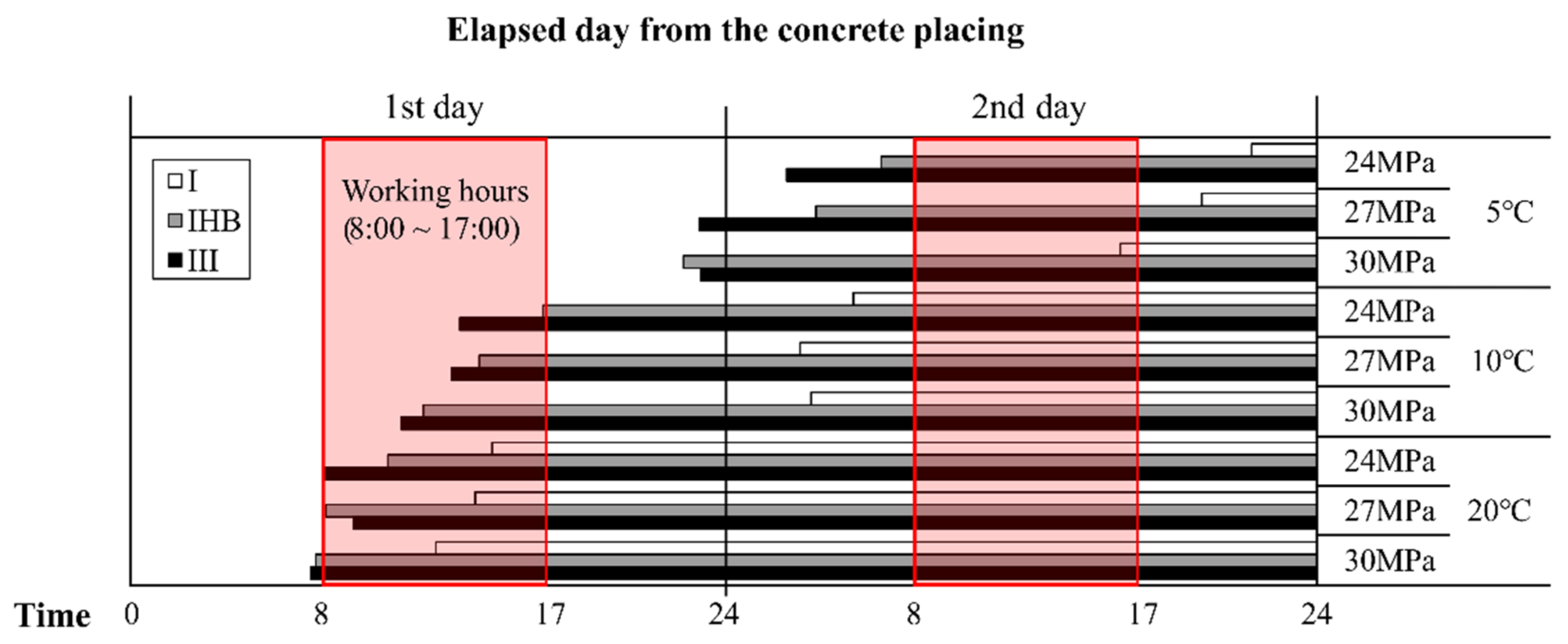
| Factors | Levels | Test Items |
|---|---|---|
| Types of cement | Type Ⅰ (1), IHB (2), type Ⅲ (3) |
|
| Curing temperature (°C) | 5, 10, 20 | |
| Design strength (MPa) | 24, 27, 30 |
| Design Strength (MPa) | Types of Cement | W/C (%) | S/a (%) | Unit Weight (kg/m3) | |||
|---|---|---|---|---|---|---|---|
| Water | Cement | Sand | Gravel | ||||
| 24 | Type Ⅰ | 48.3 | 47.0 | 160 | 331 | 837 | 980 |
| IHB | 48.3 | 47.0 | 160 | 331 | 833 | 976 | |
| Type Ⅲ | 48.3 | 47.0 | 160 | 331 | 835 | 978 | |
| 27 | Type Ⅰ | 45.5 | 46.5 | 167 | 367 | 806 | 963 |
| IHB | 45.5 | 46.5 | 167 | 367 | 802 | 958 | |
| Type Ⅲ | 45.5 | 46.5 | 167 | 367 | 804 | 961 | |
| 30 | Type Ⅰ | 42.0 | 46.1 | 165 | 393 | 791 | 961 |
| IHB | 42.0 | 46.1 | 165 | 393 | 787 | 956 | |
| Type Ⅲ | 42.0 | 46.1 | 165 | 393 | 789 | 959 | |
| Types | Physical Properties | Chemical Composition (%) | |||||||
|---|---|---|---|---|---|---|---|---|---|
| Density (g/cm3) | Blaine (cm2/g) | Soundness (mm) | CaO | SiO2 | Al2O3 | Fe2O3 | MgO | Ig. loss | |
| Type Ⅰ | 3.15 | 3420 | 0.8 | 62.44 | 21.12 | 4.40 | 3.19 | 3.10 | 3.36 |
| IHB | 3.14 | 4630 | 1.0 | 63.28 | 21.40 | 4.36 | 3.16 | 2.77 | 3.20 |
| Type Ⅲ | 3.13 | 4790 | 1.0 | 63.09 | 20.99 | 4.50 | 3.29 | 2.77 | 2.23 |
| Types | Density (g/cm3) | Unit Weight (kg/L) | Absorption (%) | F. M. |
|---|---|---|---|---|
| Fine aggregate | 2.60 | 1.69 | 0.43 | 2.6 |
| Coarse aggregate | 2.68 | 1.52 | 0.67 | 6.0 |
| Curing Temp. (°C) | Design Strength (MPa) | Types of Cement | Slump (mm) | Air Content (%) | Concrete Temp. (°C) | Setting Time (h) | Compressive Strength (MPa) | |||||||
|---|---|---|---|---|---|---|---|---|---|---|---|---|---|---|
| Initial | Final | 0.5 Days | 1.5 Days | 2 Days | 2.5 Days | 7 Days | 14 Days | 28 Days | ||||||
| 5 | 24 | Type Ⅰ | 150 | 5 | 14.4 | 22.5 | 32 | 0 | 0.9 | 3.2 | 6.6 | 22 | 28.7 | 34.4 |
| IHB | 170 | 5.8 | 14.7 | 18 | 26 | 0 | 4.1 | 8.2 | 12.1 | 26.6 | 33.6 | 35.3 | ||
| Type Ⅲ | 150 | 5.8 | 14.5 | 17.5 | 24 | 0 | 4.9 | 11.4 | 17.8 | 29.7 | 32.7 | 38.1 | ||
| 27 | Type Ⅰ | 165 | 6.5 | 13.6 | 23 | 29 | 0 | 0.7 | 2.5 | 6.9 | 24.5 | 30.9 | 37 | |
| IHB | 145 | 4.8 | 14.1 | 15 | 21 | 0 | 4.9 | 10.4 | 13.6 | 30.8 | 38.4 | 42 | ||
| Type Ⅲ | 150 | 5.5 | 13.4 | 17 | 22.5 | 0 | 6.8 | 12.7 | 22.6 | 31.5 | 38.5 | 42.2 | ||
| 30 | Type Ⅰ | 145 | 5.3 | 13.1 | 22 | 27 | 0 | 0.7 | 4 | 9.2 | 27.6 | 36 | 40 | |
| IHB | 150 | 5.6 | 13.9 | 16 | 22 | 0 | 5 | 13.9 | 17.5 | 30 | 36.5 | 40.7 | ||
| Type Ⅲ | 155 | 4.5 | 13 | 18 | 23.5 | 0 | 5.6 | 16.1 | 22 | 40 | 43.1 | 48.6 | ||
| 10 | 24 | Type Ⅰ | 140 | 5.5 | 19.5 | 22 | 27.5 | 0 | 3.9 | 7.1 | 10.6 | 22 | 24.7 | 27.1 |
| IHB | 145 | 5.6 | 17.5 | 15 | 19 | 0 | 11.3 | 14.3 | 17.1 | 26.8 | 29.1 | 30.1 | ||
| Type Ⅲ | 160 | 4.8 | 18.4 | 13.5 | 16.5 | 0 | 15 | 19.5 | 22 | 29.9 | 33.6 | 34.1 | ||
| 27 | Type Ⅰ | 145 | 5.3 | 17.9 | 18 | 24 | 0 | 5 | 9.3 | 13 | 24.8 | 25.2 | 29 | |
| IHB | 160 | 4.6 | 17.9 | 14.5 | 18 | 0 | 14.1 | 17.5 | 21 | 30 | 30.1 | 32.4 | ||
| Type Ⅲ | 160 | 3.9 | 17.7 | 13 | 16 | 0 | 15.3 | 19.3 | 23 | 35.5 | 33.1 | 38.1 | ||
| 30 | Type Ⅰ | 145 | 4.8 | 17.5 | 18.5 | 24 | 0 | 3.5 | 8.7 | 15.6 | 26.5 | 29.2 | 29.9 | |
| IHB | 150 | 5 | 17.7 | 14 | 18 | 0 | 16.2 | 20.5 | 22.7 | 31.2 | 34.4 | 34.8 | ||
| Type Ⅲ | 145 | 4.1 | 17.2 | 12.5 | 16.5 | 0 | 20 | 24.5 | 26.1 | 35 | 39.5 | 41 | ||
| 20 | 24 | Type Ⅰ | 150 | 5.5 | 24 | 15 | 17.5 | 0 | 13 | 16.2 | 18.7 | 22.3 | 27.9 | 27.8 |
| IHB | 150 | 4.1 | 23.7 | 10 | 12.5 | 0 | 18.3 | 21.1 | 21.5 | 29.1 | 32 | 31.1 | ||
| Type Ⅲ | 150 | 4.6 | 22.7 | 9 | 11.5 | 2.15 | 24.3 | 26.7 | 27.3 | 33.2 | 35.6 | 36.5 | ||
| 27 | Type Ⅰ | 160 | 5.1 | 24.2 | 14.5 | 17 | 0 | 15.2 | 18.6 | 20.3 | 25.4 | 28.6 | 28.3 | |
| IHB | 155 | 3.6 | 24.5 | 8.5 | 10.5 | 2.43 | 20.7 | 23.8 | 25 | 30.3 | 34.7 | 35.2 | ||
| Type Ⅲ | 140 | 3.9 | 24.3 | - | - | 0 | 20.2 | 24.1 | 26.2 | 30.3 | 34.9 | 36.4 | ||
| 30 | Type Ⅰ | 145 | 3.7 | 24.3 | 12 | 15.5 | 0 | 20.1 | 22.1 | 24.2 | 27.7 | 32.6 | 32.8 | |
| IHB | 145 | 3.9 | 24.1 | 8 | 10 | 1.8 | 21.8 | 23.7 | 25.8 | 32.3 | 36 | 38.1 | ||
| Type Ⅲ | 140 | 3.8 | 23.5 | 8.5 | 11 | 1.39 | 25.1 | 28.7 | 31 | 37.5 | 38.2 | 39.3 | ||
| Statistical Results | 24 MPa | 27 MPa | 30 MPa | ||||||
|---|---|---|---|---|---|---|---|---|---|
| I | IHB | III | I | IHB | III | I | IHB | III | |
| Correlation coefficient (R) | 0.962 | 0.980 | 0.977 | 0.973 | 0.990 | 0.926 | 0.943 | 0.980 | 0.974 |
| Determination coefficient (R2) | 0.925 | 0.961 | 0.955 | 0.947 | 0.979 | 0.857 | 0.890 | 0.959 | 0.949 |
| Standard error | 1.79 | 1.24 | 1.97 | 1.72 | 1.17 | 2.52 | 3.10 | 1.68 | 2.32 |
| Regression Sum of Squares | 276.1 | 266.5 | 658.3 | 373.5 | 520.2 | 266.2 | 543.5 | 531.1 | 810.0 |
| Error Sum of Squares | 22.4 | 10.7 | 31.0 | 20.7 | 11.0 | 44.5 | 67.2 | 22.5 | 43.2 |
| Total Sum of Squares | 298.4 | 277.2 | 689.2 | 394.2 | 531.2 | 310.7 | 610.7 | 553.6 | 853.1 |
| Significance F | 3.5 × 10−5 | 3.4 × 10−6 | 1.1 × 10−6 | 9.9 × 10−6 | 5.0 × 10−8 | 3.4 × 10−4 | 1.3 × 10−4 | 7.5 × 10−7 | 1.8 × 10−6 |
Disclaimer/Publisher’s Note: The statements, opinions and data contained in all publications are solely those of the individual author(s) and contributor(s) and not of MDPI and/or the editor(s). MDPI and/or the editor(s) disclaim responsibility for any injury to people or property resulting from any ideas, methods, instructions or products referred to in the content. |
© 2023 by the authors. Licensee MDPI, Basel, Switzerland. This article is an open access article distributed under the terms and conditions of the Creative Commons Attribution (CC BY) license (https://creativecommons.org/licenses/by/4.0/).
Share and Cite
Kim, J.; Shin, S. Quantitative Verification of Concrete Formwork-Striking-Time Reduction by High Blaine Ordinary Portland Cement. Materials 2023, 16, 1077. https://doi.org/10.3390/ma16031077
Kim J, Shin S. Quantitative Verification of Concrete Formwork-Striking-Time Reduction by High Blaine Ordinary Portland Cement. Materials. 2023; 16(3):1077. https://doi.org/10.3390/ma16031077
Chicago/Turabian StyleKim, Jinman, and Sangchul Shin. 2023. "Quantitative Verification of Concrete Formwork-Striking-Time Reduction by High Blaine Ordinary Portland Cement" Materials 16, no. 3: 1077. https://doi.org/10.3390/ma16031077
APA StyleKim, J., & Shin, S. (2023). Quantitative Verification of Concrete Formwork-Striking-Time Reduction by High Blaine Ordinary Portland Cement. Materials, 16(3), 1077. https://doi.org/10.3390/ma16031077






